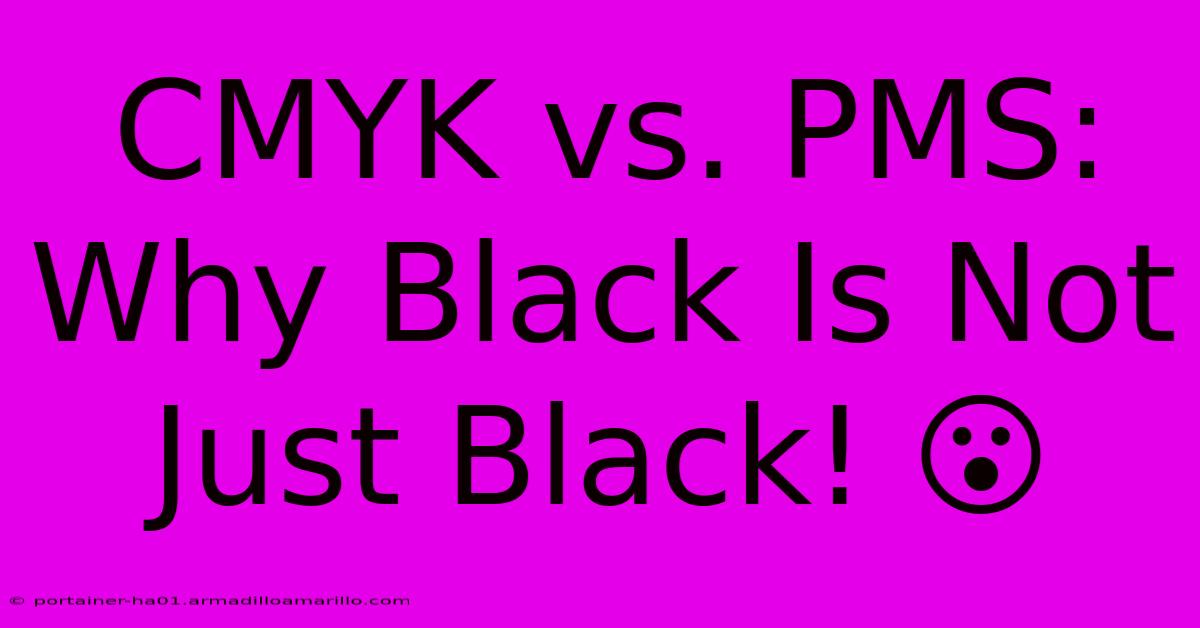CMYK Vs. PMS: Why Black Is Not Just Black! 😮

Table of Contents
CMYK vs. PMS: Why Black Is Not Just Black! 😮
Choosing the right color profile for your printing project is crucial, and understanding the difference between CMYK and PMS is key to achieving the desired results. This often leads to surprising discoveries, like the fact that "black" isn't always just black! Let's delve into the nuances of CMYK versus PMS and why color accuracy matters.
Understanding CMYK
CMYK stands for Cyan, Magenta, Yellow, and Key (black). This is the subtractive color model used in most printing processes. It works by subtracting colors from white light to create a range of hues. Think of it like mixing paints: you start with a white canvas and add colors to darken it.
The Limitations of CMYK
While CMYK is versatile, it has limitations:
- Limited Color Gamut: CMYK can't reproduce the full spectrum of colors visible to the human eye. Some vibrant colors, especially deep blues and rich reds, can appear duller in CMYK print compared to their digital counterparts.
- Inconsistent Results: Achieving consistent color across different printers and papers can be challenging with CMYK. Variations in ink, paper type, and printer calibration can significantly affect the final output.
- "Rich Black": Pure black in CMYK is often achieved by combining all four colors (Cyan, Magenta, Yellow, and Key). This is sometimes referred to as "Rich Black," and is necessary to achieve a truly deep black with a higher ink density. However, it may impact drying times and increase printing costs.
Understanding PMS (Pantone Matching System)
PMS, or the Pantone Matching System, is a proprietary color system that uses a standardized library of spot colors. Each PMS color has a unique number and formula, ensuring consistency across different printers and locations.
The Advantages of PMS
PMS offers several advantages over CMYK:
- Accurate Color Reproduction: PMS colors are highly accurate and consistent, guaranteeing that the printed colors closely match the chosen PMS color swatch. This is especially crucial for branding and corporate identity, where consistent color representation is vital.
- Vibrant Colors: PMS can produce richer and more vibrant colors than CMYK, particularly in those areas where CMYK falls short.
- Metallic and Fluorescent Colors: PMS extends beyond basic colors, offering metallic, fluorescent, and other special effects not achievable with CMYK.
When to Use PMS
PMS is the ideal choice when:
- Color accuracy is paramount: For logos, branding materials, and projects where precise color matching is essential.
- Vibrant or unique colors are needed: For projects requiring colors outside the CMYK gamut.
- Special effects are desired: For projects incorporating metallic, fluorescent, or other special color effects.
CMYK vs. PMS: The Black Hole of Differences
Now, let's address the elephant in the room: black. While CMYK uses a combination of colors to create black, PMS offers a range of distinct black colors – each with its own nuanced shade. This is where "black is not just black" becomes undeniably true. A PMS black will appear different from a CMYK black, often displaying a richer, deeper, and more consistent result.
Choosing the Right Color System
The choice between CMYK and PMS depends on your project's specific requirements:
- For large-scale print jobs with cost-effectiveness as a priority, CMYK is generally preferred.
- For projects needing highly accurate and consistent color reproduction and requiring specific spot colors, PMS is the better option.
Ultimately, careful consideration of color accuracy, budget, and project specifics will determine the best color system for your print job. Consulting with a professional printer is always a good idea, particularly for complex projects. They can advise you on the most suitable color profile to achieve your desired results, ensuring that your "black" is exactly the shade you intended.

Thank you for visiting our website wich cover about CMYK Vs. PMS: Why Black Is Not Just Black! 😮. We hope the information provided has been useful to you. Feel free to contact us if you have any questions or need further assistance. See you next time and dont miss to bookmark.
Featured Posts
-
Brace Yourself The Ultimate Bizarro List Of Footballer Names That Will Blow Your Cleats Off
Feb 07, 2025
-
Color Code Craze The Ultimate Guide For Bunting Manufacturers To Boost Visibility
Feb 07, 2025
-
Savor The Sweetness Of Typography Tt Chocolates Demibold Your Font Thats Good To The Last Byte
Feb 07, 2025
-
Transform Your Photography With Lumis Ai Genius Unlock Unlimited Possibilities
Feb 07, 2025
-
Fuel Your Creative Engine Explore The Font That Embodies Porsches Winning Spirit
Feb 07, 2025
